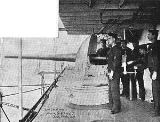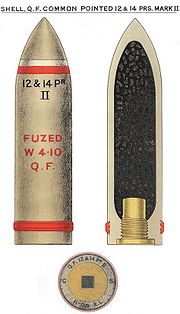
QF 14 pounder Maxim-Nordenfelt naval gun
Encyclopedia
The QF 14 pounder was a 3-inch medium-velocity naval gun used to equip warships for defence against torpedo boats. It was produced for export by Maxim-Nordenfelt (later Vickers, Sons and Maxim) in competition with the Elswick QF 12-pounder 12 cwt
and QF 12-pounder 18 cwt
guns.
in 1897. In 1900 they were removed, mounted on field carriages and went to China with the Victorian Naval Contingent to confront the Boxer Rebellion
. These 2 guns were non-standard and fired QF fixed rounds (i.e. the cartridge was loaded with shell attached) unlike the standard guns which fired separate ammunition (i.e. shell and cartridge loaded as separate items). They were therefor left behind in China in favour of the standard QF 12-pounder.
In Victorian naval service in the 1890s the gun is reported as firing a shell weighing 14 lbs to a range of 8,000 yards with a muzzle velocity of 2100 ft/second, using a 6.5 lb black powder charge.
, Fort Pearce
and Fort Queenscliff
.
QF 12 pounder 12 cwt naval gun
The QF 12 pounder 12 cwt gun was a common calibre naval gun introduced in 1894 and used until the middle of the 20th century. It was produced by Armstrong Whitworth, Elswick and used on Royal Navy warships, and exported to allied countries...
and QF 12-pounder 18 cwt
QF 12 pounder 18 cwt naval gun
The QF 12 pounder 18 cwt gun was a 3 inch high-velocity naval gun used to equip larger British warships such as battleships for defence against torpedo boats...
guns.
Victorian Navy service
2 guns were mounted on HMVS CerberusHMVS Cerberus
HMVS Cerberus is a breastwork monitor that served in the Victoria Naval Forces, the Commonwealth Naval Forces , and the Royal Australian Navy between 1871 and 1924....
in 1897. In 1900 they were removed, mounted on field carriages and went to China with the Victorian Naval Contingent to confront the Boxer Rebellion
Boxer Rebellion
The Boxer Rebellion, also called the Boxer Uprising by some historians or the Righteous Harmony Society Movement in northern China, was a proto-nationalist movement by the "Righteous Harmony Society" , or "Righteous Fists of Harmony" or "Society of Righteous and Harmonious Fists" , in China between...
. These 2 guns were non-standard and fired QF fixed rounds (i.e. the cartridge was loaded with shell attached) unlike the standard guns which fired separate ammunition (i.e. shell and cartridge loaded as separate items). They were therefor left behind in China in favour of the standard QF 12-pounder.
In Victorian naval service in the 1890s the gun is reported as firing a shell weighing 14 lbs to a range of 8,000 yards with a muzzle velocity of 2100 ft/second, using a 6.5 lb black powder charge.
Victorian coastal artillery
14 pounders were used for coastal defence at Fort NepeanFort Nepean
Fort Nepean is a former defensive facility occupying part of Point Nepean, Victoria, Australia. It was part of a network of fortifications, commanded from Fort Queenscliff, protecting the narrow entrance to Port Phillip.- Background :...
, Fort Pearce
Fort Pearce
Fort Pearce is a former defensive facility occupying part of Point Nepean, Victoria, Australia. It was part of a network of fortifications, commanded from Fort Queenscliff, protecting the narrow entrance to Port Phillip.-Fortifications:...
and Fort Queenscliff
Fort Queenscliff
Fort Queenscliff, in Victoria, Australia, dates from 1860 when an open battery was constructed on Shortland's Bluff to defend the entrance to Port Phillip. The Fort, which underwent major redevelopment in the late 1870s and 1880s, became the headquarters for an extensive chain of forts around Port...
.
Royal Navy service
The Royal Navy did not adopt the gun, but acquired several in 1903 by default when the British government bought the battleships Constitucion and Libertad under construction for Chile, due to fears that they would eventually be acquired by Russia. They each carried 14 of the guns and went on to serve as HMS Swiftsure and HMS Triumph respectively. In British service the guns fired the same 3-inch 12.5 lb shell as QF 12-pounder guns.British ammunition
In British service the guns fired the same 3-inch 12.5 lb shell as QF 12-pounder guns. |
 |
 |
 |

